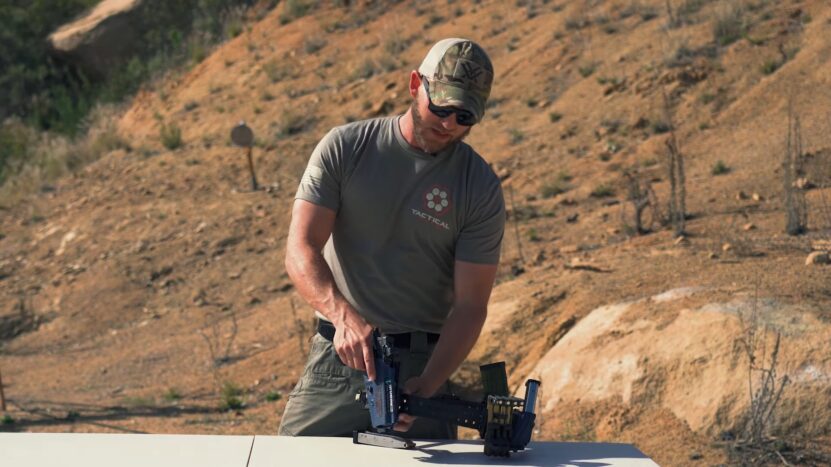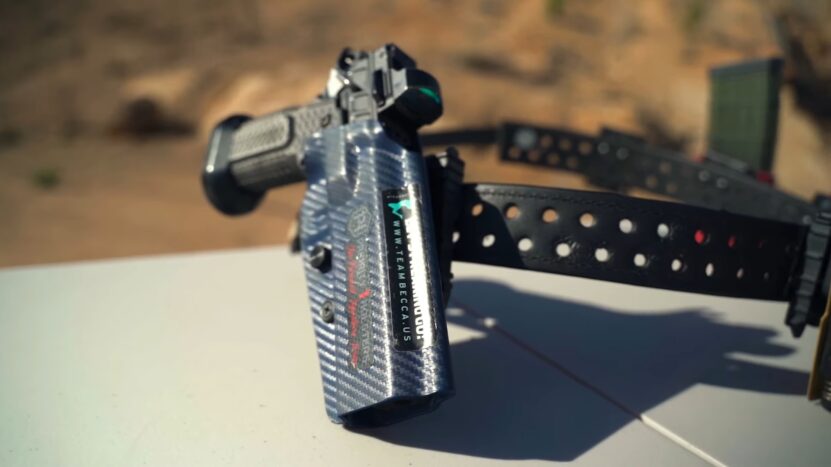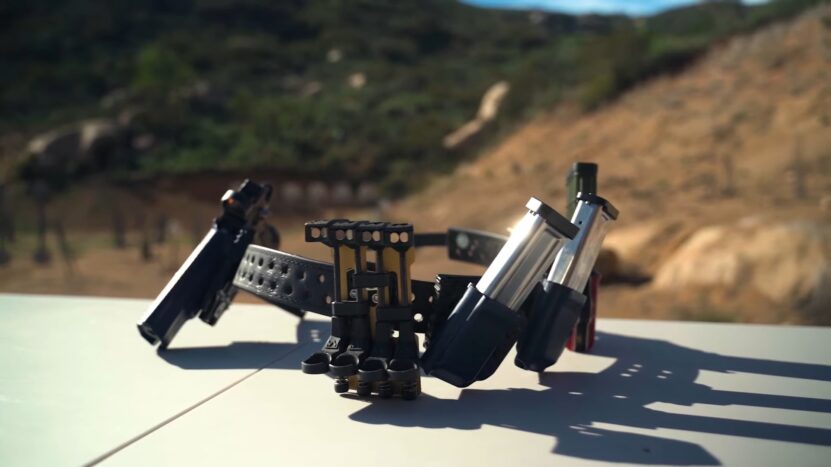In the world of firearms, versatility is often key. Whether you’re a security professional, a competitive shooter, or simply someone who likes to be prepared, having quick access to multiple firearms can be crucial.
Enter the 3-Gun Belt—a belt designed to securely hold three guns. The concept of a 3-Gun Belt isn’t new. Historically, gunslingers of the Wild West often carried multiple firearms, ensuring they were never caught off-guard.
In this guide, I’ll walk you through the process of setting up your very own 3-Gun Belt.
Choosing the Right Belt
- Material and Durability: Given the weight and importance of what you’ll be carrying, you need a belt that’s both sturdy and durable. While leather is a classic choice known for its durability, modern materials like reinforced nylon can offer flexibility and strength.
Pro Tip: Look for belts with reinforced stitching and high-quality buckles. These small details can make a big difference in the belt’s longevity.
- Width and Support: A wider belt, often between 1.5 to 2 inches, provides better weight distribution and support. This ensures that the guns stay in place and don’t sag or shift as you move.
- Adjustability: Given that you’ll be carrying three guns, the ability to adjust the belt for comfort and fit is crucial. Look for belts with multiple adjustment points or modular designs.
Fun Fact: Some modern 3-Gun Belts come with padding or gel inserts for added comfort, especially when carrying heavier firearms.
Essential Holsters for Your 3-Gun Belt
- Primary Firearm Holster: This is where your primary or largest firearm will reside. It should offer a balance between security and accessibility. Features like adjustable retention and cant can help customize the draw to your liking.
- Secondary Firearm Holsters: These will hold your secondary and tertiary firearms. Depending on the size and type of guns you’re carrying, you might opt for holsters with different designs or retention systems.
- Placement: Think about how you’ll draw each gun. Some shooters prefer a cross-draw for their secondary firearm, while others opt for a straight draw for all three. Experiment with different placements to find what feels most natural and efficient for you.
Pro Tip: Consider the order in which you might need to access the guns. For instance, if you anticipate needing your pistol before your revolver, place the pistol in a more accessible position.
Arranging the Gear

When it comes to a 3-Gun Belt, the organization isn’t just about aesthetics; it’s about efficiency and safety. Here’s how to get the most out of your setup:
- Balance and Weight Distribution: Distributing the weight of your firearms evenly can prevent strain on your back and hips. If you’re carrying one particularly heavy firearm, consider placing it opposite two lighter ones to balance things out.
Pro Tip: When arranging your firearms, move around and practice drawing each one. Adjust their positions based on what feels most natural and balanced.
- Accessibility: Consider which firearm you’ll need to access first in a given situation. Your primary firearm should be the most accessible, with the secondary and tertiary firearms positioned based on their order of importance.
- Safety First: Ensure that the trigger guard of each firearm is fully covered by its holster. This prevents accidental discharges while drawing or reholstering.
Fun Fact: Some shooters use color-coded holsters or markings to quickly identify each firearm on their belt.
Setting Up the Pistol Holster
Your pistol is likely to be the firearm you draw most frequently, so its placement is crucial:
- Position: Most shooters prefer their pistol to be located on their dominant side for a quick and natural draw. However, depending on your training and preference, you might opt for a cross-draw or appendix position.
- Retention: Your pistol holster should have a reliable retention system, whether it’s a thumb break, strap, or tension screw. This ensures your pistol stays secure during movement but can be quickly drawn when needed.
- Cant and Angle: The angle at which your pistol sits can affect your draw speed and comfort. Some shooters prefer a forward cant, especially for larger pistols, as it can make the grip more accessible.
Pro Tip: Spend time practicing your pistol draw. A smooth, consistent motion can significantly reduce your draw time.
Placing Secondary and Tertiary Firearms

- Holster Type: Depending on the firearms you’re carrying as your secondary and tertiary choices, you might need different types of holsters. For instance, a small backup revolver might fit best in a pocket holster, while a subcompact pistol might require an IWB (Inside the Waistband) or OWB (Outside the Waistband) holster.
- Positioning: These firearms should be placed where they can be quickly accessed after your primary firearm. Consider positions like the small of your back, cross-draw, or even shoulder holsters.
- Safety Considerations: Just like with your primary firearm, ensure the trigger guards of your secondary and tertiary firearms are fully covered. Additionally, regularly check the retention systems to ensure they’re functioning correctly.
Fun Fact: Some shooters opt for “breakaway” holsters for their secondary firearms, allowing for a faster draw in close-quarters situations.
Organizing Shotgun Shell Caddies
If one of your three firearms is a shotgun, having quick access to shells is crucial:
- Type of Caddy: There are various caddy designs, from belt-mounted options to chest rigs. Depending on your shotgun type and shooting style, you’ll want to choose the one that offers the quickest reload time.
- Shell Orientation: This is vital for efficient loading. Some shooters prefer the brass-up orientation for quick grabbing, while others go for brass-down. It largely depends on your reloading technique.
Pro Tip: If you’re using a semi-automatic shotgun, consider having a separate compartment or pouch for slug rounds, in case you need them.
- Retention: Ensure that the caddy securely holds the shells, even during rapid movements. The last thing you want is to drop shells during a crucial moment.
Fun Fact: The world record for the fastest time to load and shoot five shotgun shells is just over 2 seconds!
Practice and Adjustment

Setting up your 3-Gun Belt is just the beginning. To truly master it, you need to practice:
- Dry Practice: Before heading to the range, spend time practicing your draw and reload for each firearm in a safe environment. This helps in building muscle memory and identifying any issues with your setup.
- Live-Fire Drills: Once you’re comfortable with dry practice, head to the range. Run through various scenarios, focusing on transitioning between firearms and reloading under pressure.
Pro Tip: Time your drills. This gives you a benchmark to improve upon and helps in identifying areas that need more practice.
- Adjust Based on Feedback: After each practice session, make any necessary adjustments to your belt setup. Maybe a holster needs to be moved an inch, or a magazine pouch angle needs tweaking. Small changes can lead to significant improvements.
Maintenance and Upkeep
Your 3-Gun Belt will see a lot of action, so regular maintenance is essential:
- Inspecting Gear: Regularly check your holsters, pouches, and caddies for any signs of wear and tear. Look for loose stitches, worn-out Velcro, or damaged retention systems.
- Cleaning: Dirt and debris can affect the functionality of your gear. Regularly clean your holsters and pouches, ensuring they’re free from obstructions.
- Lubricating Moving Parts: If your holsters have mechanical retention systems, ensure they’re lubricated and functioning smoothly.
Pro Tip: Always have a small repair kit with essential tools, extra screws, and replacement parts. This can be a lifesaver during competitions or extended-range sessions.
Longevity and Performance

When you’ve invested time and resources into setting up your 3-Gun belt, it’s essential to ensure its longevity and optimal performance.
- Regular Inspection: Just like any other piece of equipment, your 3-Gun gear requires regular checks. Look out for signs of wear and tear, especially on the holster and magazine pouches. Remember, a malfunctioning piece of equipment can cost you valuable seconds in a competition.
- Replacing Components: Over time, some components of your setup might wear out. It’s essential to replace them promptly. For instance, if the retention system of your holster loosens, it might not hold your pistol securely, leading to potential safety hazards.
- Cleaning and Lubrication: Dirt and grime can accumulate, especially after a long day at the range. Ensure that all moving parts, especially in your holster and magazine pouches, are clean and well-lubricated. This not only ensures smooth operation but also extends the lifespan of your gear.
Pro Tip: Use a soft brush and a damp cloth for cleaning. Avoid using harsh chemicals that might degrade the material of your gear.
FAQ
How tight should the belt be worn?
Your belt should be snug enough to hold all your gear securely without causing discomfort. If you can slide a finger comfortably between the belt and your waist, that’s a good fit.
Can I use my regular belt for 3 Gun competitions?
While it’s possible, it’s not advisable. A purpose-built belt ensures proper gear attachment and distributes weight evenly, providing stability during competitions.
What’s the best way to practice reloads with the belt setup?
Dry practice is a great way to start. Set up a routine where you practice drawing your pistol, changing magazines, and transitioning between firearms. Once you’re comfortable, incorporate live-fire drills to improve reload speed and accuracy.
Should I carry more magazines/shells than required?
It’s a balance between carrying enough ammunition and not being weighed down. Always carry a little extra, but remember, every additional magazine or shell adds weight.
What’s the recommended order of equipment on the belt?
While there are general guidelines, the order largely depends on user preference and efficiency. Most shooters prefer having their pistol holster on the dominant hand side, followed by pistol magazines, rifle magazines, and then shotgun shell caddies.
Final Words
Setting up a 3-gun belt is a blend of science and art. While there are guidelines and best practices, the final setup should cater to your unique shooting style and preferences. Remember, the key is to strike a balance between accessibility and comfort. And as with any skill, practice is paramount.
Regularly test your setup, make necessary adjustments, and always prioritize safety. Happy shooting!
If you’re interested, we suggest checking out our article on the top 5 long shooting ranges in Dallas.
Pro Tip: Join local 3-Gun clubs or associations to learn from experienced shooters and get hands-on practice in a controlled environment.
